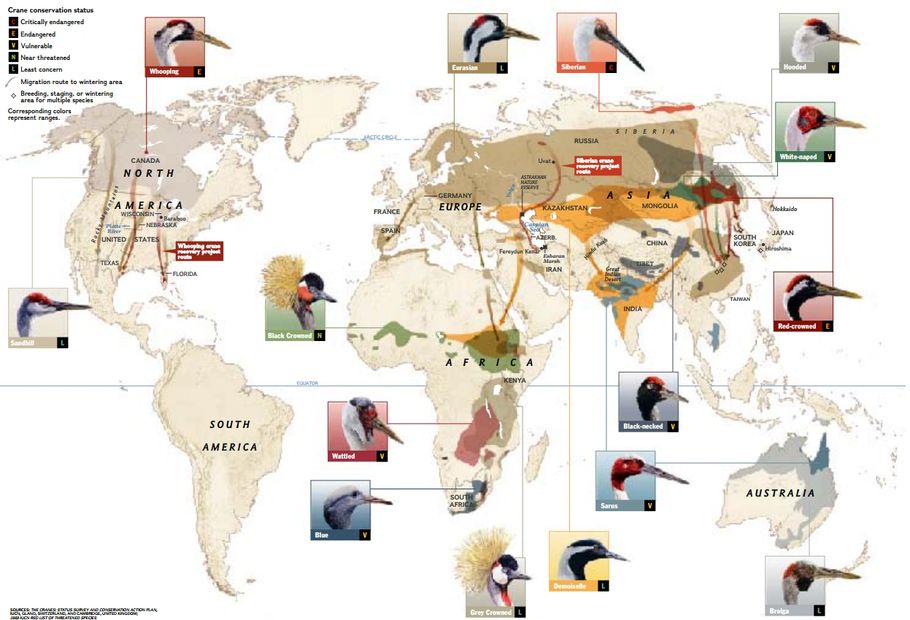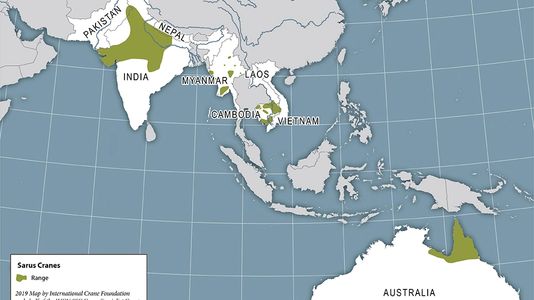Cranes of the World

There are 15 Species of Cranes in the World!
Crane conservation remains a daunting challenge. Cranes are among the most endangered families of birds in the world, with eleven of the fifteen species threatened with extinction. Despite threats from rapid development and habitat loss, poisoning, hunting and more, cranes continue to unite people throughout the world through their charisma and symbolism of fidelity and longevity.ut your business here.
Sarus Crane

Grus Antigone
HEIGHT: ~ 176 cm, 5.8 – 6 ft WEIGHT: ~ 6.35 kg, 14 lbs POPULATION: ~ 15,000 – 20,000 W TREND: South Asia and Australian populations uncertain; China-Myanmar population stable; Lower Mekong Basin population decreasing SUBSPECIES: antigone – Indian,sharpii – Eastern gilli – Australian
FUN FACT
The Sarus Crane is the tallest flying bird in the world!

Range of Sarus Cranes in the World
The current range of the Indian Sarus Crane includes the plains of northwestern India, the western half of Nepal’s Terai Lowlands and parts of Pakistan. The Eastern Sarus Crane occurs in Myanmar, Laos, Vietnam and Cambodia. The Australian Sarus Crane occurs in northern Australia. Found in Pakistan, India, Bangladesh and Burma. The species has been extinct from Malaysia, Thailand and Philippines.

Sarus Crane in Nepal
In Nepal, Sarus Crane is mostly found in the farmlands of Lumbini, Kapilavastu and Nabalparasi districts (western Terai Region). Some Sarus Cranes were recorded in eastern Nepal (Siraha etc.) but the current status is not well known.
Identification
Identification
Identification
Long-necked, long-legged birds with tapering body. Cranes are large, beautiful, graceful, long-lived birds. The crane family is wide spread existing on five of the seven continents (Only Antarctica and South America do not have cranes). The flight is powerful, with the head and neck extended forwards and legs and feet stretched out behind. Flocks of cranes often fly in V-formation; they sometimes soar at considerable heights.
Range
Identification
Identification
The current range of the Indian Sarus Crane includes the plains of northwestern India, the western half of Nepal’s Terai Lowlands and parts of Pakistan. The Eastern Sarus Crane occurs in Myanmar, Laos, Vietnam and Cambodia. The Australian Sarus Crane occurs in northern Australia.
Diet
Threats
Threats
Aquatic plants, roots and tubers of wetland plants, small mammals & reptiles, eggs of other birds, worms, clams, crayfish, grains, and insects etc.
Threats
Threats
Threats
Water diversions and unsustainable conversion of wetlands, habitat loss, poisoning, human disturbance, collisions with power lines, invasive species and changes in agricultural practices.
Sarus Habit and habitat: Most cranes are gregarious outside the breeding season, and flocks are often very noisy. Cranes have a characteristic resonant and far-reaching musical trumpet-like call. Feeding is one of the cranes' most time-consuming activities. Cranes spend most of the daylight hours in areas where food is most abundant. Cranes forage for roots and the starchy swellings found on the roots of certain plants called tubers. They also eat seeds, small mammals and reptiles, eggs of other birds, and invertebrates, such as worms, clams, insects, and crayfish. The bill is used to probe and dig for plant roots and to graze and glean vegetable material above the ground. Both sexes have a spectacular and beautiful dance that takes place throughout the year. Cranes do not have webbed feet, but they can swim, although adult birds usually avoid deeper water unless necessary. Chicks are good swimmers and may leave the nest to follow the parents through the wetlands, sometimes within a few hours of hatching.

Our Plan
Securing the Sarus Crane population in Nepal (particularly Lumbini) through community-supported conservation practices and governmental policies that maintain the rich biodiversity of agricultural landscapes. We are:
- Managing and operating a Crane Sanctuary and a demonstration site at Lumbini, the birthplace of Buddha, to showcase the Terai landscape of Nepal used by Sarus Cranes and provide conservation education based on the Buddhist love for nature.
- Regular Sarus survey and Monitoring and Nesting counts
- Reducing threats to Sarus Crane populations from power line collisions, illegal conversion of wetlands and poisoning by agricultural and industrial chemicals..
- Collaborating with village councils, farmers and conservation partners to identify and implement strategies that preserve the agricultural and wetland landscapes supporting cranes and communities.
- Partnering with the nepalese conservation community on advocacy to improve state and federal wetland policy.
